
One of my favorite things about fictional works is trying to understand their fantastical worlds and the cosmology behind their universes. However, in order to do that, I not only like to look into what is said directly in the base work but also look into the behind-the-scenes inspirations for the creation of that world.
The Pokémon series always developed its worldviews in very interesting ways, although the developers were limited due to what they could the games themselves could show during the early days, as Pokémon got more generations they increased the scope of the world more and more, to the point of some early elements being changed.
The so-called 4th Generation of the series introduced the Sinnoh Region and with it some of the Pokémon with the highest scale of influence so far, the Creation and Lake Trio alongside the Mythical Pokémon called Arceus.
The 4th generation games were made with the keyword “Ultimate” in mind and developed the “ideal world”, for that reason over-the-top legendaries were created for those games, and the ones who embody infinite time and space were born.
Since those Pokémon are very connected to the meaning of the universe as a whole, trying to understand them might help to discover more about how the world itself works and the ideas that were used to create it.
Meaning of Universe – Space and Time


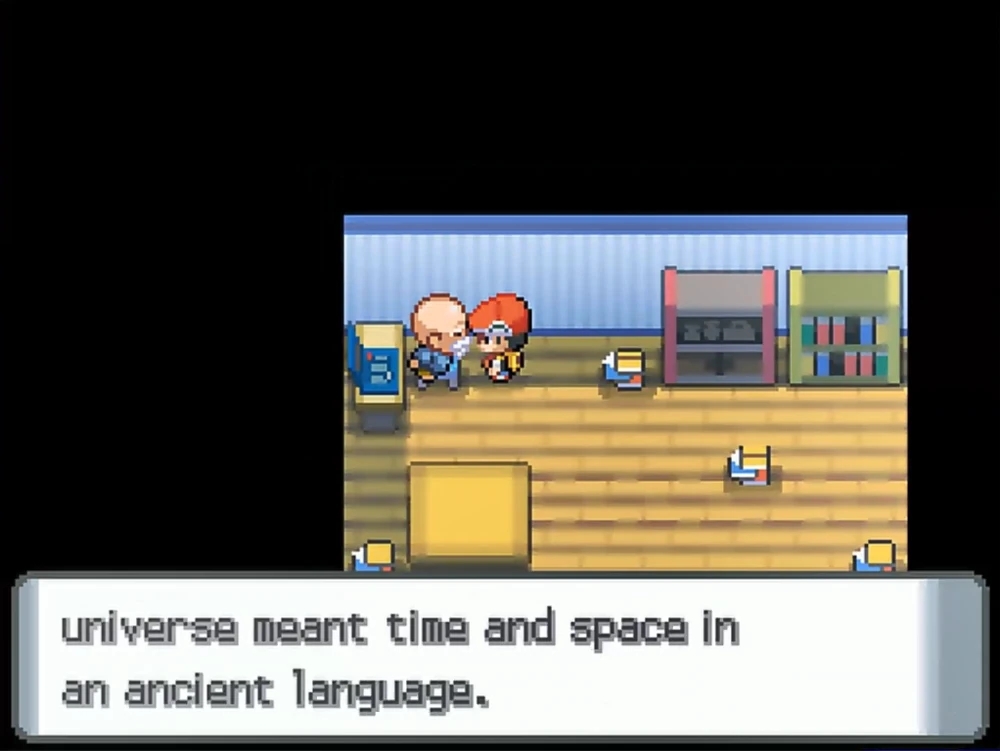
In the game it’s possible to see some references to the idea that the word “universe” carried the meaning of time and space in an ancient language, this is a detail that is most likely lost in translation, but it’s what gives context to all of Cyrus’ desires.
The word “Universe” as we know it comes from the Latin “universus” and means “turning one”, of course, its meaning is “all that is”. However Pokémon isn’t a series made in English, so the meaning might be somewhere else… For that let’s look back into the etymology of the word “Universe” in Japanese.
“世界” (Sekai, World) in Japanese has been transmitted from Chinese and has its roots in a Buddhist translator’s translation of the Sanskrit लोकधातु. The first “世” (Se) carries the meaning of generation and time “Past, Present, and Future”. The second carries the meaning of spatial directions “North, South, West, and East”. It makes sense then that “Sekai” would mean “All of time and space”.
“宇宙”(Uchū, Universe) also has a similar origin. In this case, “宇” (U) means “Up, Down, Right, Left, Front, and Back”, and “all directions”, so it’s a word that carries the meaning of space. “宙” (Chū) means “Past, Present, and Future”, so it’s a word that carries the meaning of time.
In both cases the words carry the meaning of “all of time and space” and this is what the Pokémon games are talking about when referring to the meaning of “universe”, but that was in Japanese and Chinese, so it’s a detail that is mostly lost in translation. In the “Pokémon Special” manga, this is a detail that is directly mentioned by Cyrus during the explanation of his objective, as the etymological origin of the word “Universe” only mentions time and space, a third aspect (Spirit) would go against that definition. This specific detail was removed from the official Viz translation of the manga (Although they could have gone to the exact same solution of the localization and so explain that it’s “a meaning from a lost civilization”).



When Cogita describes about the universe as being made of time and space, she describes the definition I gave above.




In the Japanese version of the game, as expected, she is more direct and gives the meaning for the two kanji that make up the word “Uchū”. As she explains, the universe is made up of time (From the past to the future) and space (Every spatial direction). “宇宙”(Uchū, Universe) means “時間と空間” (Jikan to Kūkan, Space and Time).




With this concept in mind, Dialga and Palkia were created as Pokémon that would represent infinite time and infinite space as explained by Masuda. With that in mind, let’s look more in-depth at the meaning of space and time that they represent.
Dialga’s domain – Past, Present, and Future
“時間” (Jikan) is composed of two kanjis, the first “時” (Ji, can also be read as Toki) is a word that carries the sense of time while “間” (Kan) carries the meaning of interval, space in between.
Dialga is the Temporal Pokémon (じかんポケモン, Jikan Pokémon) and so it has domain over Time. To be more direct, it’s said that Dialga’s birth is what started the flow of time and as its heart beats the flow continues, as stated even on its Smash Bros Trophy, in a sense Dialga is time. Being the Temporal Pokémon, Dialga has total control over time and can freely travel to the past or the future.






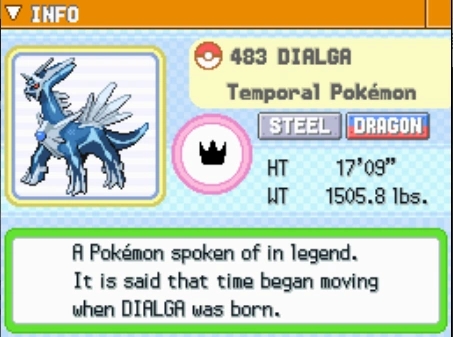

The flow of time has a sense of never-ending and no matter what happens it always continues to flow, for that is Dialga’s blessing.




As with Palkia, Dialga lives in a different dimension (異次元, I jigen) from the conventional one. In Viz translation of the “Pokémon Diamond and Pearl Adventure!” manga, it’s stated that this happened because they originally fought with each other and this is some kind of punishment, this, however, isn’t stated in the original text that simply states that each of them remained in their dimensions in order to maintain the balance between each other, the Red Chain causing the Dimensional Rift caused an imbalance in space-time and the two had no option other than cancel each other out.





This dimension is merely called “Dialga’s space” (ディアルガの空間, Diaruga no kūkan) in the 12th movie “Arceus – To the Conquering of Time and Space”. In “Pokémon Platinum” the rift that leads to Dialga is stated to emanate “an overwhelming feeling of time” while in “Pokémon Alpha Saphire” the area surrounding the gap where you fight Dialga is stated to be “very quiet as if time had somehow stopped”.



Still in the 12th movie, and later in the 18th movie “The Archdjinn of the Rings, Hoopa”, we can have a look into that place as a blue space with crystal-like objects floating there. When Ash and the others travel through time using Dialga’s power, it’s possible to notice that they move across a similar space.



The “Pokémon Special” manga has a place called “Time Gap” (時間の狭間, Jikan no hazama), officially localized as “Crack in time”, a place where space is twisted and can be used to travel through time. Considering the context for the next Pokémon, it wouldn’t be a surprise if Dialga’s space was a realm like this.



On a similar note, in “Pokémon Mystery Dungeon: Explorers of Time/Darkness/Sky” Dialga hid the Temporal Tower in a Time Gap (ときの はざま, Toki no hazama), the space between the change in time, and it sounds like a similar enough concept.



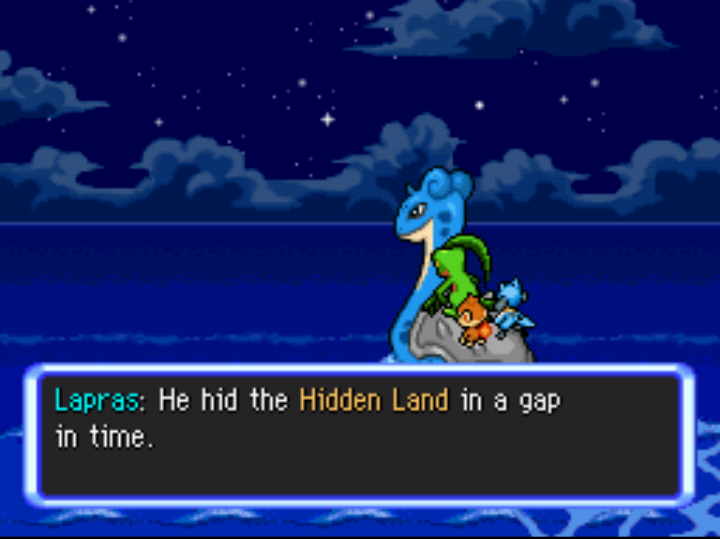

Palkia’s Domain – Perpendicular and Parallel
While Dialga’s domain as the Temporal Pokémon is very clear, Palkia’s, the one who created and stabilizes space, is a bit more nuanced.


“空間” (Kūkan) is composed of two Kanji. The second one was already explained on the previous topic, so the focus here is on “空” (Kū), it’s one that contains the meaning of space, air, and atmosphere. Ignoring “間” on the two terms I explained results in the term “時空” (Jikū) that, of course, is a term that refers to space-time.
Palkia is the “Spatial Pokémon” (くうかんポケモン, Kūkan Pokémon), but “space” carries a more diverse meaning when compared to Dialga’s time and we can notice that while reading Palkia’s title in the English game and the original Japanese material.


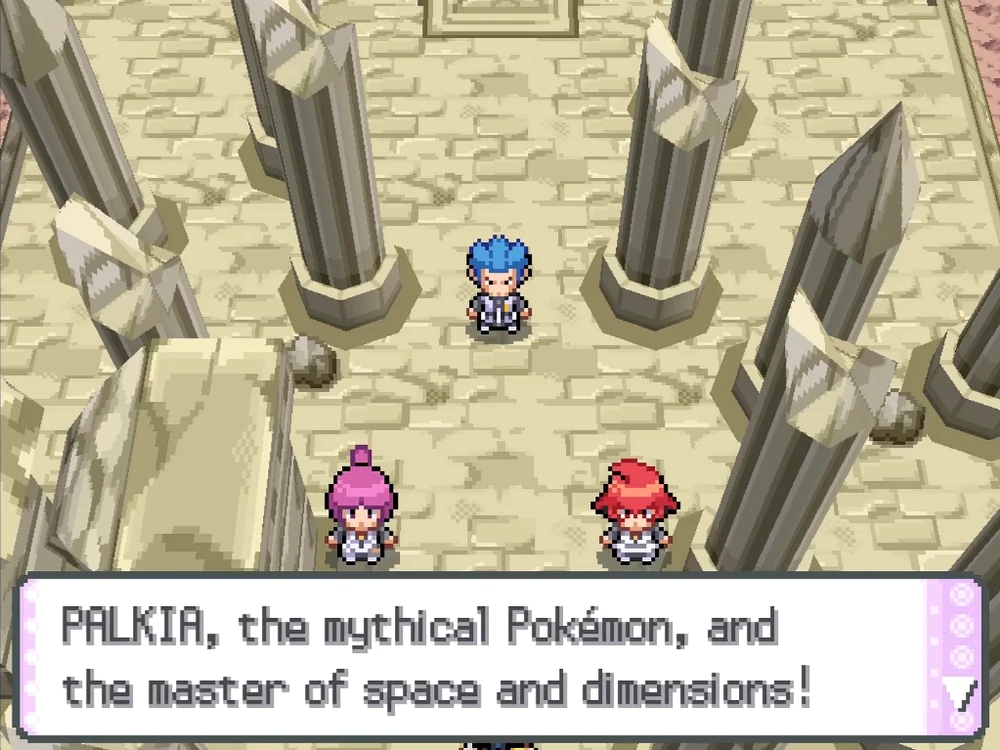

In the English Localization of the game, while summoning Palkia, Cyrus states “PALKIA, the mythical Pokémon, and the master of space and dimensions!”. In the Japanese version, however, Cyrus says “空間を 司る 神話の ポケモン パルキアよ” (Palkia, the mythical Pokémon that controls Space”.
While localizing the game a more detailed description was given, why? Although most games would have their localizations disregarded when discussing this, as Pokémon translations are made in-house with overseen by the development team, the translators are given explanations and notes in regard to the background settings of the series and the localized text makes use of that kind of information. So, it makes sense to think that “space and dimensions” is a valid translation for “空間” (Kūkan), and that is exactly the case.
When talking about dimensions, the Japanese word normally used for it is “次元” (Jigen), but of course, that is also very connected with “空間” (Kūkan). Spatial Dimensions are, of course, perpendicular directions in space and while describing the meaning of space in the first topic the definition was “Front and back, left and right, up and down” which is a reference to the directions in 3-dimensional space.
However, the notion of “Parallel Dimensions” are also very popular, and often “次元” (Jigen) is used to denote a different dimensional world (異次元世界, I jigen sekai). It’s no surprise, then, that the term “空間” (Kūkan) can also be used to talk about a different world or pocket reality in that sense, and in Pokémon games, most of the time that something is translated as “dimension” the original term was “空間” (Kūkan).
One common example of it is Palkia being mentioned in regard to “spatial dimensions”, while the original text talks about “Space”. But we can look more at other examples from the series and see this standard being applied.


The best example of this is the “Dimensional Research Lab” from Pokémon Sun/Moon/Ultra Sun/Ultra Moon. This place in the Japanese version is called the “Spatial Research Lab” (空間研究所, Kūkan kenkyūjo). Yes, although the English version of the text says “dimension” all the time, the original wording says “space”. As I explained above, this isn’t a bad translation because both words can be used in the same way. Below are some examples that show the scenes from the English version that uses “dimension/dimensional” while the original Japanese version uses “space/spatial”. Also, some other Japanese materials do use the word “dimension” (次元) showing that in this context Space is used to mean “different world/alternate dimension”, as it’s with Bronzong’s entry that does show “another world” in the context of studying “another space/dimension”.












An interesting example of this is the “Interdream Zone” that was the subject of Burnet’s research before going to Alola, while it’s refered to as a “dimensional space” in the translation, it’s in fact called “空間” (Kūkan) in the original text. While at this, the “Interdream Zone” is called “夢のはざま” (Yume no hazama) that we could translate it as “Dream Gap” similar to the Time Gaps I mentioned before. The word “はざま” (hazama) is often used in the sense of “gap, interval, space in between”, in this sense it refers to the space in between dreams (The Pokémon Dream World) and reality, like the “時間の狭間” (Jikan no hazama) and “ときの はざま” (Toki no hazama) seems to refer to the space between instants of time.












With this in mind, we can look into other descriptions of Palkia and see how it talks about spaces. In Eterna City, there’s a mention of Palkia’s blessing over the world, in the localization Palkia is called “the creator of parallel dimensions”. As expected Palkia is mentioned only as the “creator of space”, but it does refer to more than one, so in this context, it could refer to parallel dimensions as used in the localization.






Finally, it’s time to talk about the place where Palkia lives, a place called “Palkia’s Space” (パルキアの空間, Parukia no kūkan) in the 12th movie “Arceus – To the Conquering of Time and Space”. In that movie and later in the 18th movie “The Archdjinn of the Rings, Hoopa”, we can have a look into that place as a pink space with bubbles floating there. In “Pokémon Platinum” the rift that leads to Dialga is stated to emanate “an overwhelming feeling of space” while in “Pokémon Omega Ruby” the space surrounding the gap where you fight Palkia is stated to be “”distorted as if it had somehow been twisted”.




In the localized games, it’s said that Palkia lives “in a gap in the spatial dimension parallel to ours” as if in direct relationship to a certain dimension, there was a book in particular that used this to say that Palkia lives between the standard dimension and Dialga’s dimension. The original text is a more direct saying “並行して並ぶ空間の狭間に住むと言われている” that translates into “Said to live in the gap between (狭間, hazama) spaces lined up in parallel (並行して並ぶ 空間, Heikōshite narabu kūkan)”.
This change is very common in regards to any profile about where Palkia lives, even on Pokémon Go while they talk about Palkia “returning to its spatial dimension” the original text says returning to the “spatial gap” (空間の狭間, Kūkan no hazama). Curiously enough, in the 10th Pokémon movie “Dialga VS Palkia VS Darkrai” while talking about Palkia they directly mention “次元の狭間” (Jigen no hazama) with this one directly meaning “gap between dimensions”.





Other details about this can be found on Palkia’s profiles that describe how it can use its power to travel to “other dimensions”, as expected in the original material it says “Different space” (異空間, I kūkan), but it’s clear that it’s using as a reference to different worlds, such as the fact it’s included on the Spatial Research Lab’s examples of different spatial worlds. Finally, in the recent “Pocket Monsters” anime series Palkia’s power is used as an example of the power that can travel to different worlds and it’s showcased how its fight with Dialga also affects different worlds is the reason behind the entire plot of the two episodes.

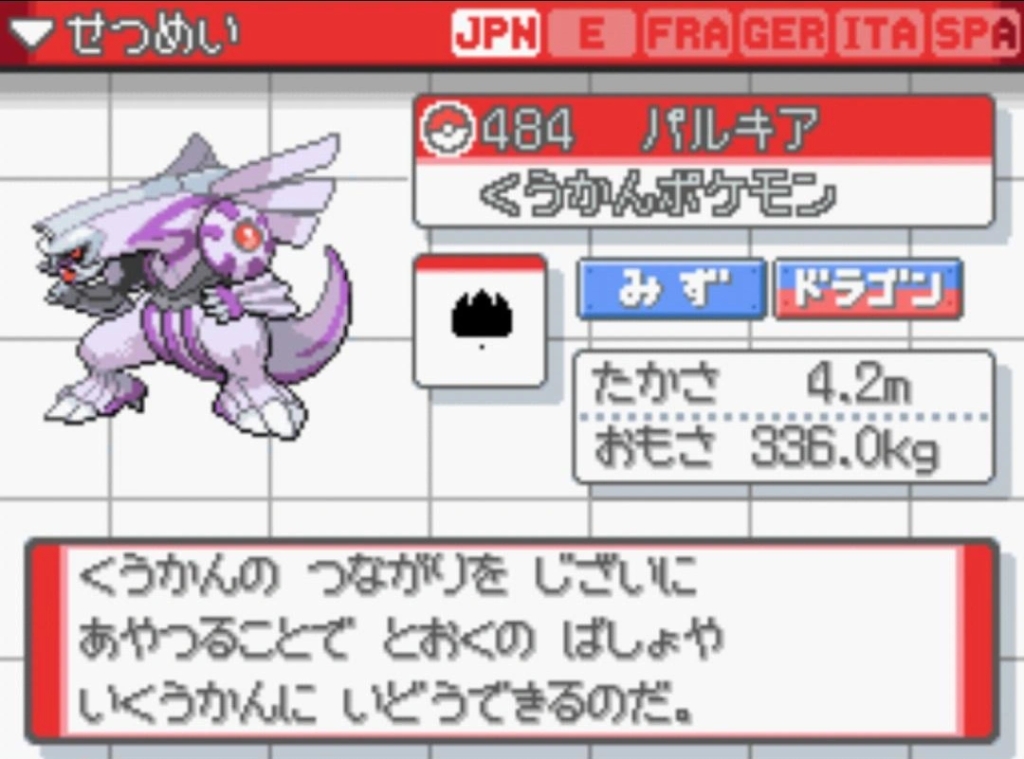


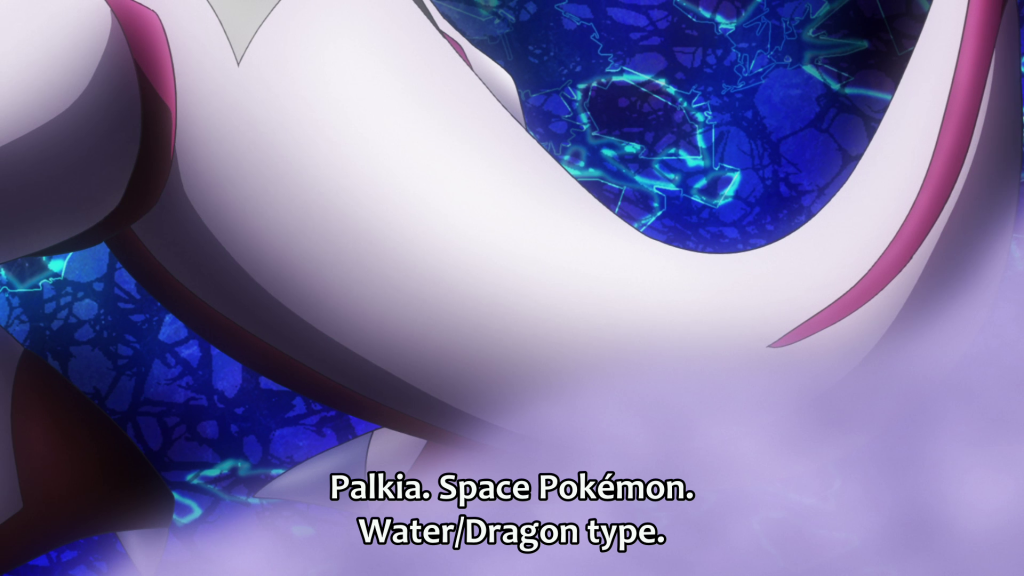




Giratina -The Paradox of Time and Space





Giratina is an interesting element in the Pokémon legends as there has been a lot of misunderstanding in regard to what it represents, especially due to its position as “The Pokémon of the Antimatter World”. This is a detail that was never detailed on the original games for the 4th generation, although they were mentioned in some interviews, there was a clear degree of being its own thing as they stated that anti-matter was “something — it’s there, but it’s something you can’t see“.
Although they would later talk more about real-world inspirations while developing the 4th Generation games, the way it was mainly explained in concept was clearly not a reference to real-world antimatter.
Antimatter in physics terms refers to matter composed of antiparticles, those that have opposite characteristics such as their charges, when they enter in contact with conventional matter that we are made of, the two are annihilated releasing energy via mass-energy conversion (E = MC^2 as stated on the interview above).
However, the way anti-matter, or rather the anti-matter world of Giratina, works definitely isn’t like that. Instead of something literal, it’s more likely that they took the concept behind the relationship between matter and anti-matter and build Giratina’s relationship with Dialga and Palkia around that, as they stated “There’s a concept in particle, in physics called CP violation. It helps explain the relationship between matter and antimatter. The relationship is bipolar. The reality is that anti-matter is something that’s very, very fragile”.
In “Pokémon Generations” in the episode “New World”, Cyrus ends on the Distortion World, the world ruled by Giratina, and refers to it as a “world of nothing” that is basically the world he seeks, a world without spirit. On the website of Pokémon Platinum, it was stated that “the distortion world is ruled by a concept that is neither time nor space”, one where the rules of time and space don’t apply. Considering that Dialga and Palkia are the Pokémon of Time and Space if Giratina was to be really an opposition to them, then being “Anti Space-Time” would be the right definition, and that is basically the case.






In regards to Pokémon Platinum Masuda gave various definitions for the idea behind Giratina and the Distortion World and we can see exactly that his idea was that of something opposite to the physical world of time and space ruled by Dialga and Palkia.
GS: Can you tell us about the new features in Platinum and the thinking behind each of the additions?
TK: The most significant new feature would be Distortion World. When we started developing Platinum, Masuda explained some key concepts, such as “antimatter,” “E=MC²,” and “There’s an antimatter world, a paradox of time and space that exists in relation to Dialga and Palkia.” Among the flood of concepts he gave me was a term called “Reversed Mt. Fuji” (“Sakasa Fuji”). Masuda explained that Sakasa Fuji refers to the reflection of Mt. Fuji on the lake, which embodies the antimatter world. I thought of how I could incorporate all the concepts into Platinum and did extensive research. I didn’t really understand what antimatter meant at first, but I think I was able to grasp the concept eventually and conveyed it in the game.
Pokemon Platinum Q&A: Giratina, Anti-Matter, and E=MC2
IGN: What are some of the major changes for the Distortion World?
Kawachimaru: The focus for the Distortion world is, of course, Giratina. So from the beginning, the concept has been how Giratina fits in the world. Mr Masuda explained to me what the distortion world is and what kind of Pokemon Giratina is. So base don that we created new music and something very visual. So as soon as you go into the distortion world, everyone will understand how different that world is. That was something very important we always kept in mind.
Junichi Masuda: When I created the music for battling Giratina, I thought of the front/back, life/death. There’s bipolar, opposite ideas. So that’s something I kept in mind when I created the battle music.
Pokemon Creators Get Personal (IGN)
IGN: What was the inspiration for the new concepts in Pokemon Platinum? Do you think the process for coming up with new concepts has changed since the first Pokemon games were developed?
Junichi Masuda: We created Platinum with a new method of determining the game’s direction that was based on the image of one Pokemon – Giratina. When I imagined Giratina, the idea of a “reversed world” came to my mind. I thought of concepts such as “E=mc2” and matter and antimatter. There is no top or bottom, no left or right. We increased the number of developers for Diamond and Pearl, so we wanted to clarify the game concepts for the team before we started the project Its better to hammer out the overall vision of the game first, and then all the team members will work towards that vision by throwing out ideas. The concept of “ultimate” was what we started out with for this title.
Pokemon Creators on Platinum (IGN)
Masuda: “While developing Diamond & Pearl, Giratina originally embodied the idea of an ‘antiworld,’ which is a paradox of Time and Space. It exists in relation to Dialga and Palkia. That’s what I had in mind when I was developing Diamond & Pearl.”
Kawachimaru: “I was not aware of any of that during the Diamond & Pearl’s development. Masuda told me about it when we started developing Platinum. So it was after Diamond & Pearl for me (laughs). I normally receive key terms from Masuda in the first stage of development, but there were many random terms like ‘antimatter’ and ‘e=mc2,’ ‘Reversed Mt. Fuji’ (‘Sakasa Fuji’) and so on. He explained that ‘Sakasa Fuji’ is the reflection of Mt Fuji on the lake, and it’s the antimatter world. It was challenging to put that concept into the game, so we did extensive research. I didn’t know what exactly ‘antimatter’ was either. I personally think I comprehend it well, but I wonder….
Masuda: “Yes. It exists but it actually doesn’t. It doesn’t exist but it does. That sort of thing. The mountain exists on the lake through human eyes, but it’s only a reflection and doesn’t exist. It’s a diverse world. You see it only because you are looking at it with your eyes. I’m impressed [with Kawachimaru] for being able to take ingredients that were not substantial and incorporate them into Platinum.”
Talking Pokémon (Nintendo Power 240)
There’s often a detail in the 11th movie, “Giratina and the Sky’s Bouquet: Shaymin”, that is often overlooked while trying to understand the Distortion World (Or the Reverse World as it’s called in the movie), the fact that it’s somehow related to reflections in the real world. This often overlooked detail is in fact the key to understanding the concept behind Giratina and the Anti-matter world. Instead of “Anti-matter” as a matter that has opposite charges to conventional one, it’s a reference to something that literally doesn’t exist and is better understood as a “reflection” or “shadow” of the real world. It’s a place that lacks time and space, “Anti Space-time”.





The Distortion World is often described as “a world with no concept of time or space”, “a place beyond time and space” or “a separate dimension, where the laws of Time and Space don’t apply” and “causality gets distorted”. These are all references to the original idea that the Distortion World is the Antiworld that doesn’t exist in time and space.





This detail is in fact mentioned in the games and other material but is often overlooked in understanding what Giratina is. In Pokémon Platinum when Cynthia first enters the world alongside the player, she describes it as a world where “time isn’t flowing” and “space isn’t stable”.





The mangas “Pokémon Special’ and “Pokémon Diamond and Pearl Adventure!” explains this in more detail. As stated many times, the Distortion world is a chaotic world (混沌の世界, Konton no sekai) with “No Up, Down, Left, Right, or time” (上下も左右も時間, Jōge mo sayū mo jikan). If you remember from the initial topic the meaning of space is “Up, Down, Left, Right, Back and Front” while that of time is “From the Past to the Future”, the fact that the Distortion World lacks “up and down” and “time doesn’t flow” isn’t a reference to things like strong gravity as fans often theory, but rather to “timeless” and “spaceless”, the lack of time and space.

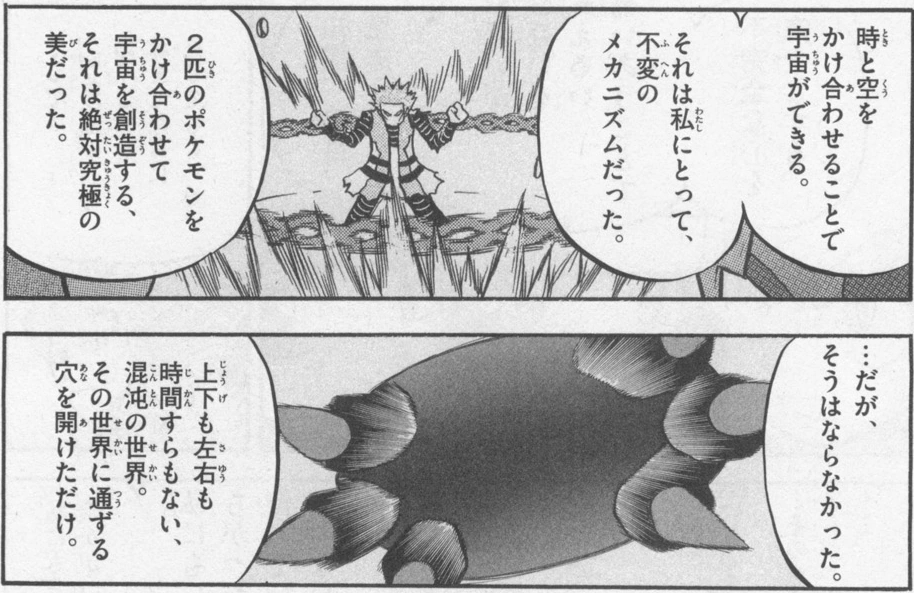




However, this is still only one of the examples of the Distortion World being the “Anti-World”, there’s also another example. While explaining the examples of dualities the Distortion World and the conventional world can represent, one of them was “life and death”. It’s often theorized that the Distortion World has something to do with the “Ghost World” mentioned in some Pokédex, such as the fact that in the Turnback Cave where you can find Giratina there’s a “Spirit World Cloth”.
The Turnback Cave (Called the Returning Cave in Japanese) is a place where space is twisted and is located on the 4th lake that was hidden. There are inscriptions stating that it’s a place where two worlds overlap, one with “those whose lives shine” (命輝くもの, Inochi kagayaku mono) and “those who lost their lives” (命失ったもの, Inochi ushinatta mono). That is the place where you can meet Giratina, enter the Distortion World, and also find the Spirit World Cloth, so there’s really some evidence to that, including the fact it’s mentioned in the very story.






After the adventure in the Distortion World Cynthia returns to their world with the player and they end on the Sendoff Spring, there Cynthia mentions that is a place said to lead to the “great beyond”, of course, the original term is “あの世” (Anoyo) that means “the afterlife“. This is also referenced in the manga “Pokémon Special” where some characters suggest that the “Afterlife” is how the Distortion World was known.








In regards to this, alongside being known to live in the “Distortion World”, also known as “the world on the other side of this world”, it’s also stated that Giratina appears in an ancient cemetery. Among the Sinnoh Myths, there’s one talking about Pokémon that were eaten having their bones cleaned, and being put in the water because later they would return. Due to the name “Return Cave” which is connected to the Sendoff Spring that has the mysterious 4th lake, it’s a common theory in the Japanese fanbase that the Sendoff Spring is the graveyard that is mentioned on the Pokédex.











Although it’s stated to be the “Antiworld”, the Distortion World and Giratina exist to maintain the balance of space-time. This is going to be clear later, but it’s very likely that Giratina’s domain is based on the idea of necessary duality and that two opposites are necessary to give each other definition. That is, Time and Space only exist if there’s something timeless and spaceless to balance them.
This is explained by Cyrus at the near end of the adventure in the Distortion World, where he compares the Distortion World and their world with a DNA strand with two chains with opposing characteristics in a spiral, each chain could replicate itself and regenerate the other if one of them were to be broken, therefore the Distortion World would act and fix the balance in space-time if a destructive distortion appeared.




















This is an idea that has been made clear about the game in other material and even in the 11th movie the Reverse World is also presented as a world that exists to support the balance of space-time and allow the Real World to exist.












The Meaning of the Spirit, Mind, and Heart






The three Pokémon of the lakes are on the other side of the space-time legend. Being born Uxie, Mesprit and Azelf gave us knownledge, emotions, and willpower that make up our “Spirits”. Like with the Creation Trio, let’s first look at their keywords.






The word used to refer to what the Lake Trio symbolizes is “心” (Kokoro) and in the localization, the most common term used is “Spirit” although sometimes “mind” or even “brain” is also used. Originally “心臓” (Shinzō) refers to an organic heart with the first symbol meaning “heart” and the second giving the meaning of “internal organ”. Removing the last symbol, “心” gives the idea of a metaphysical Heart that by definition refers to “The totality of Willpower, Knownledge, and Emotions“, exactly what the three Pokémon of the lakes represent. But… there’s also more to the Heart than this…


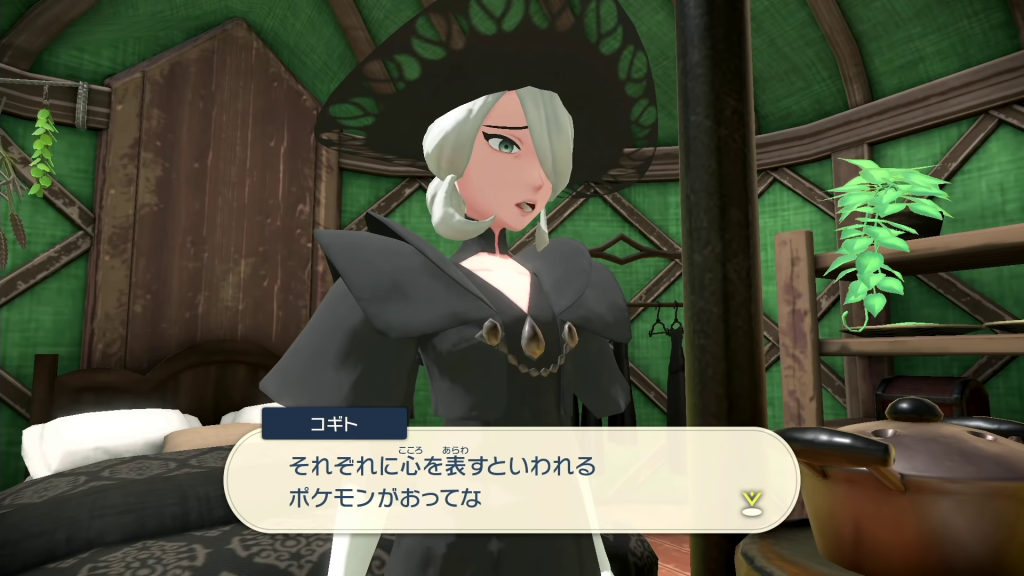


Arceus – The All-Encompassing Heart
After finishing a lot of content in Pokémon Platinum the player can interact with Cynthia in an event where she discusses the cave painting at Celestic Town giving her an understanding of the painting. It has always been thought that the mural represented the three Pokémon of the lakes with Dialga or Palkia in the center, but it’s possible that it can also represent a second trio with Giratina, Dialga, and Palkia and a mysterious fourth power in the center.
In the first interpretation, it represents the lake trio maintaining the balance with the mythical Pokémon. The second one has Dialga and Palkia, the Pokémon of time and space, alongside Giratina whose power seems to oppose that of them maintaining a certain kind of balance, who is the Pokémon in the center? The platers in Sinnoh indicate a power higher than that of Dialga and Palkia, and this is what we will discuss now.














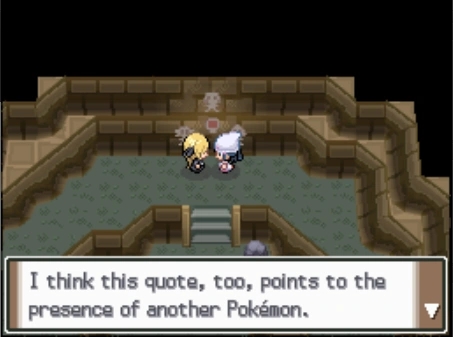





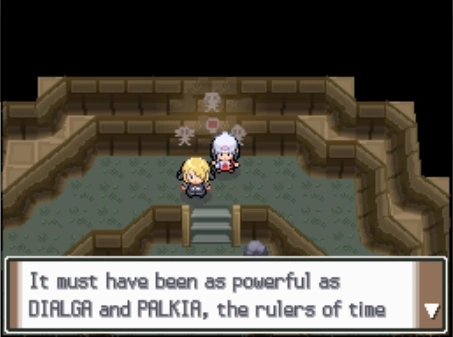












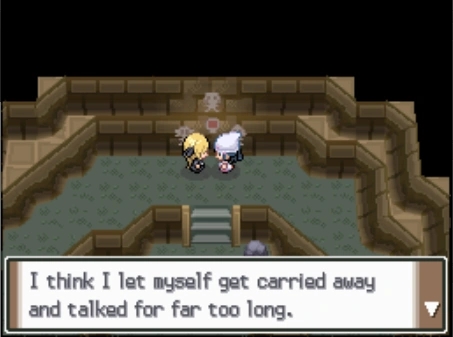

Still, in “Pokémon Platinum”, the player can talk with a Hiker that will discuss more the myths about the origin of the world, and here we get into very interesting stuff.

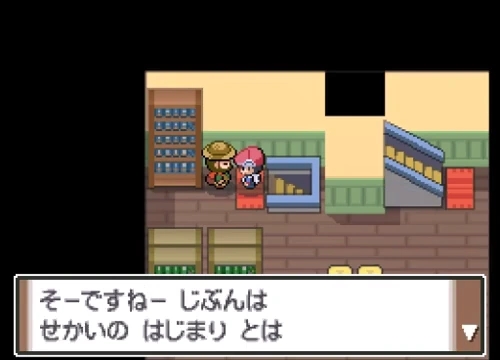


























Space Pokémon Palkia










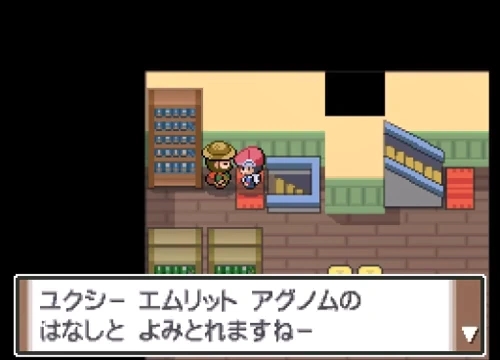



The Hiker uses the Sinnoh Myths and tries to find an interpretation that describes how the world was created. The way he sees it the world was created at the moment people’s Heart sprout, when that Heart was born they started to perceive/recognize (認識, Ninshiki) the world. This is a detail that is mentioned in Pokémon Legends Arceus by Cogita and how she explains that it’s possible that it’s because of the existence of the Mind that the world exists as Time and Space need to be perceived by the Mind in order to have a form, the Red Chain granted from the power of the Lake Trio (Or directly by Arceus in the anime) can be seen as a tool that helps to perceive the right way.




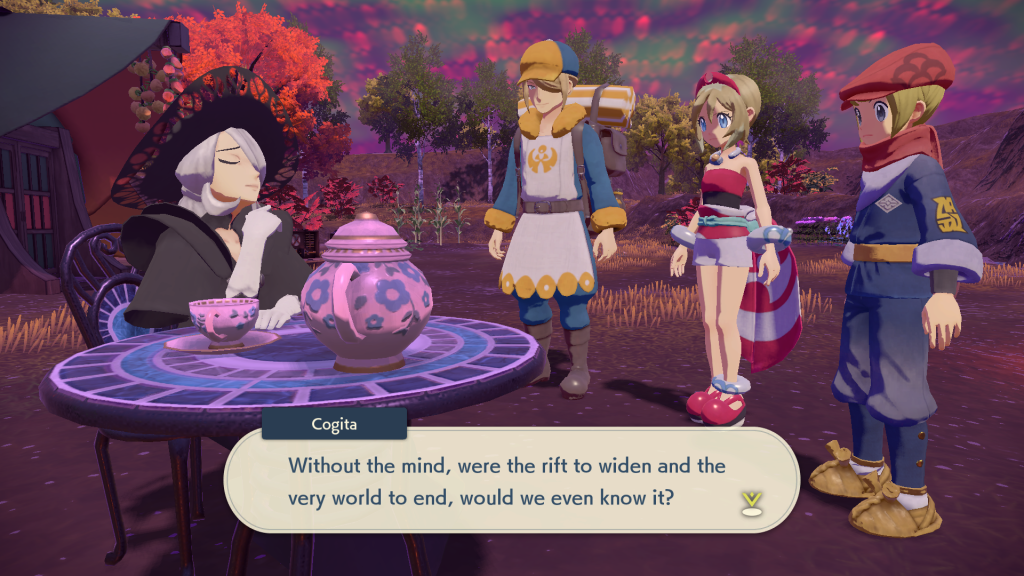








The so-called “The Story of the Beginning” (初まりの話, Hatsu mari no hanashi) at Canalave Library talks more about the creation of the world and brings up a point that I should address now. According to this material, the birth of Dialga and Palkia are referred to as the First One creating “avatars” (分身, Bunshin). This term is made up of two elements, the first “分” means to share or divide something, while “身” refers to the body, to one-self. Bunshin is then a “division of the body”.
In Shintoism and Taoism there’s a process called “分霊” (Bunrei) that differs from the previous one with the second term, “霊” means spirit, soul, and therefore means “division of the spirit”. In the practice, it refers to the process of dividing a main god from the main shrine and giving a new shrine the part of the original god, and although the original god isn’t considered lesser by any means, the new god, its bunrei, is considered to be inferior in some way. The part of the original god can be called both a Bunshin and a Bunrei and they can be created infinitely, it can be thought that all that exists would be a Bunshin of the original god in some way, who is both every single being and none at the same time.


















In “Pokémon Heart Gold/Soul Silver” there’s a special event where the player meets Cynthia in the Sinjoh Ruins and together with Arceus they enter the Mystri Stage where Arceus will make the “act of creating life out of nothing”. There Cynthia explains about Arceus creating Space, Time, and Anti-matter, whose intersection is what is generally called “The World”, which makes sense when discussing the etymology of the world Sekai as I explained earlier. There’s also an extra detail that Cynthia calls the Distortion World the world “in opposition to Space and Time”.
















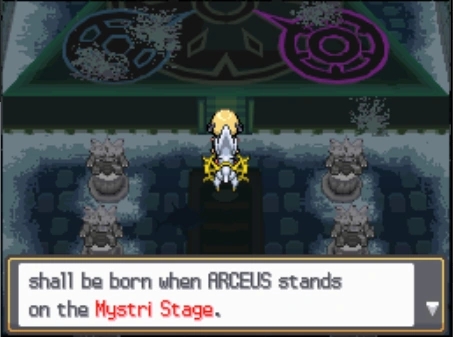
















Ever since the 4th generation the Plates that Arceus carries contains a text that tells more about the creation of the world, with the recent Pokémon Legends Arceus not only there are 19 plates in all, but they each contain a different text. Following is the text for them (Alongside the Japanese version of the text that was extracted from the game’s data with Kanji). Also, the text isn’t really in order, only the first plates had an order in the Platinum version with the Hiker’s event, but here we still don’t know the order of the plates.



















宇宙 生まれる前 そのもの 独り 呼吸する
Before the universe was born, It breathed alone
宇宙 生まれた場所 そのもの 始まりの場所
The place where the universe was born, it’s Its Place of Origin
宇宙 生まれしとき その欠片 プレートとする
When the universe was born, its fragments turned into Plates.
プレートに与えた力 倒した巨人たちの力
The power of the defeated giants was given to the Plates
そのもの 時間 空間の2匹 分身として世に放つ
It released as avatars in the world two beings of time and space
そのもの 時間 空間を つなぐ 3匹の ポケモンをも生みだす
It also created three Pokémon to bind time and space3匹のポケモンの力 時間 空間を しばし止める
For a brief period, the power of the 3 Pokémon can keep in place time and space
2匹に物 3匹に心 祈り 生ませ 世界 形づくる
The two for matter and the 3 for heart prayed for their creation, and the world was shaped
そのものの 力の欠片 珠にこめて 大地に埋める
It put fragments of its powers in gems and buried them in the ground
生まれてくる ポケモン プレートの力 わけあたえられる
When the Pokémon are born, the powers of the Plates are distributed
プレート握りしもの さまざまに変化し力ふるう
Wielding their power, the holder of the Plates can change in various ways
荒ぶる分身 怒りの雷を放つ
The rageful avatar unleashed thunders of rage
そのものの 荒ぶる 分身 世界の裏側を与えられる
It gave to the rageful avatar the other side of the world
世界の裏側に 満ちるもの 息吹くものの 姿を変える
That which fills the other side of the world is something that breaths and can change shape
世界の裏側 時間 空間の理 異なる
The space-time logic on the other side of the world is different
世界の裏側 乱れるとき 時空の裂け目 生じる
When there’s a disturbance on the other side of the world a space-time rift is created
そのもの 有らゆる所に いる そのもの 有らゆる所に いない
It is everywhere, It is nowhere
そのもの プレートの力 集めし 笛の音色を聴く
It gathers the power of the Plates listening to the Flute’s song
そのもの 有らゆる 宇宙で ポケモンと 人を みる
It looks for Pokémon and Humans in every universe
Pokémon Legends Arceus (JP Script)
According to the description so far, Arceus is introduced as a being who was once everything from nothingness, it started to grow and created avatars that first were manifestations of the very structure of the world. As stated in the Japanese version of Pokémon Diamon/Briliant Diamond, the deity Pokémon are considered the “embodiment” of their concepts, such as Dialga being the “Embodiment of Time” (時間の化身, Jikan no keshin). The way that Giratina is described in the Legends Arceus Pokédex implies it to be the embodiment of the “shadow” created by a powerful light, considering that Arceus is that light (Or the act of creation in the Big Bang), it would follow the general idea of the darkness representing the absence of light, and therefore Giratina represents the world that isn’t in contrast to the world of space-time that is.



It’s often said that the Pokémon of the lakes were all born from the same egg, with each of them being a different aspect of the Heart that exists in every living being (As mentioned in Legends Arceus and “Pokémon Diamond and Pearl Adventure!” manga). In the “Pokémon Special” manga, it’s specified that were once part of the same “Heart” before being divided into “Willpower”, “Emotion”, and “Knownledge”, considering what was explained mainly in the Japanese version of the Pokémon Platinum event it can be said that this is a reference to the original state of the Heart before the world was made, what is mostly called the “Original One” in the English localization.



The way that these Pokémon retain existence and a continuous story have never been directly addressed in any media so far. The closest to that was in the manga “Pokémon Special” where the legendary Pokémon when created are said to still have the memories of what happened in the past, also they are still said to return to their proper place after the adventure, which meant Giratina returning to the Distortion World and Dialga and Palkia to the Spear Pillar. The implication is that the existence here was still the same, or at least shared, with that which already existed, or Arceus was merely granting them a form to manifest in that place. The English localization of the manga went in a similar direction it Arceus having merely “recreated them” or “gave them form again”.



If the Pokémon of Time, Space, Anti-Matter, Knownledge, Emotion, and Willpower embody their respective concepts, Arceus who was once all there was is also the embodiment of everything. As mentioned by Volo in Legends Arceus, he’s called the “all-encompassing deity”. The term in the Japanese version is “全なる神” (Zen naru kami), “全” means “everything, all”, the “なる” can be used to say “becoming” or “to do”, and “神” of course refers to a god. The general term seems to mean “The God who is All”, “The God that can do All”, or just the “All God” or “Omnipotent God”.



In the opening of “Pokémon Legends Arceus”, we have Arceus itself talking about its realm that exists beyond time and space, something also mentioned by Gogita later on. In the Plates, it’s mentioned that “It” exists everywhere and nowhere (Although the English Localization simplifies a lot of mentions about Arceus to “Original One” the term closest to that in Japanese “最初のもの”, Saisho no mono, is nearly never mentioned, the term that is mostly used in Japan is “It”, そのもの, Sonomono). In a way, if it’s thought of Arceus, or rather the spirit of which the physical Arceus is a manifestation, is the origin of everything that created many avatars to give the world a shape, it’s not wrong to think of everything in the realms of time and space to still be part of the original spirit, and therefore it still is “all-encompassing”. At the same time, the total existence of the Heart goes far beyond time and space as it’s understood, so there are still things in the world that aren’t known.








In Pokémon Mystery Dungeon games, there are some interesting statements about Arceus. First in “Explorers of Sky” there’s a statue of Arceus saying “Beyond space-time, one Heart” followed by the player character calling about Arceus having created everything. After that, the player gains the “Space Globe” said to hold the power to pass through space and time itself. The Japanese name for the item is “Space-Time Orb” (じくうのオーブ, Jikū no ōbu) said to be the ultimate orb with the power to transcend space-time.


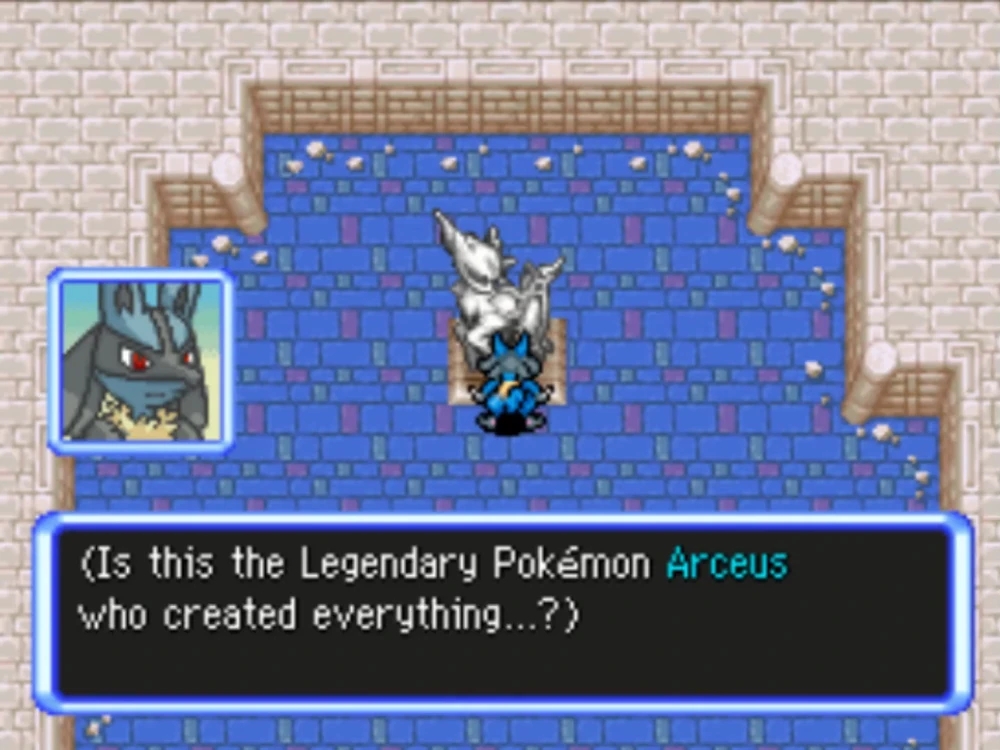


In “Pokémon Super Mystery Dungeon” after having connected with every other Pokémon, the player can find Arceus and make a bond with it. After being able to call Arceus to dungeons, it’s possible to trigger a dialogue with Arceus where it tells a bit about its nature and that of the universe as a whole. According to Arceus, it is an existence within nothingness that both exists and also doesn’t exist and everything has two sides. The description is similar to what is said about Arceus in the plates which tell more about its existence, but there’s more.
わたしは アルセウス。 無の中の有。
I’m Arceus. The existence within nothingness.
わたしたちも 宇宙も 有であり無…… すべては 表裏一体なのです。
We and the universe are both existent and non-existent…Everything has two sides.
Arceus in Pokémon Super Mystery Dungeon
This is a detail that seems to not be much known, but as explained by Junichi Masuda in the “Pokémon Heart Gold & Soul Silver” OST booklet, Arceus is a Pokémon with the image of “A God who transcends everything” (すべてを超越した神, Subete o chōetsu shita kami). This detail is often not well known, but it was mentioned before when Arceus was first announced and even for the 12th movie the director Kunihiko Yuyama explained on the movie’s making that Arceus “contains the setting of the creator of the world that is omnipotent and omniscient“, the reason for why it was so hard to make use of him in the movie. This was something shared with Hidenori Kusaka that was in charge of the “Pokémon Special” manga and also had no idea how to make a story using Arceus if they were to defeat what was basically God, reason for why it was decided to turn Arceus into a “challenging God”. The idea was to have humans themselves figure out what happened wrong in the past and fix their own mistakes with Arceus hoping for them to make the correct choice.


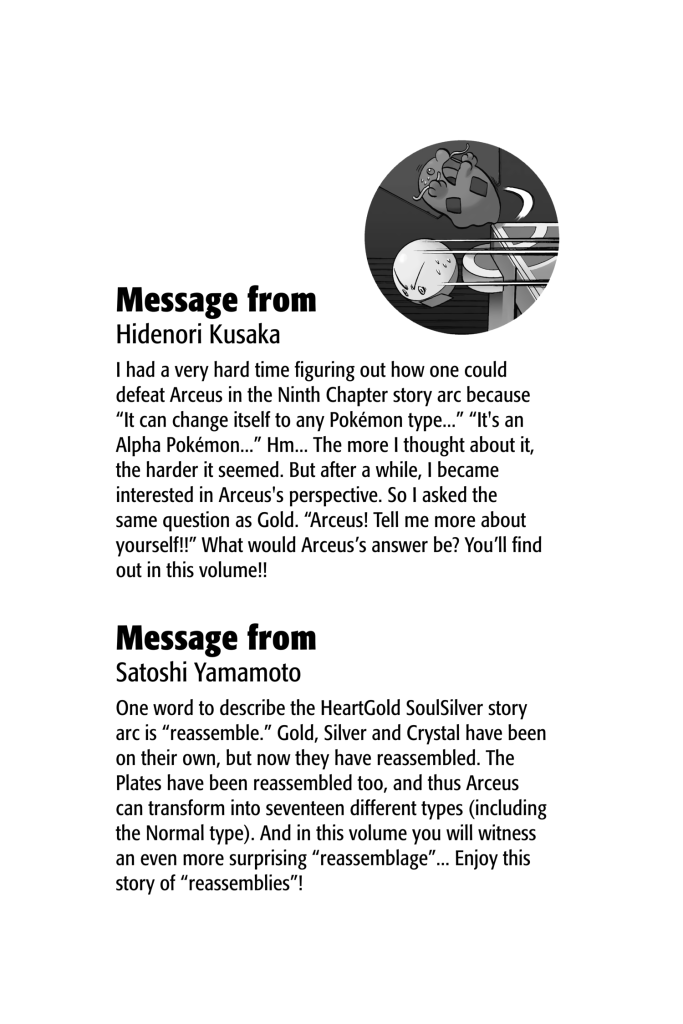
Lastly the anime special “The Arceus Who is Known as a God” goes in a similar direction as what Hidenori was going for, as Arceus here is presented as an overseen entity who looks over both humans and Pokémon whishing that they stand together against adversity so they can solve their own problems. The novelization of “The Archdjinn of the Rings, Hoopa” seems to have gone in a similar direction presenting Arceus as a “Higher Power” that was overseeing everything that was happening and acting in order to allow Hoopa to make the correct decision.








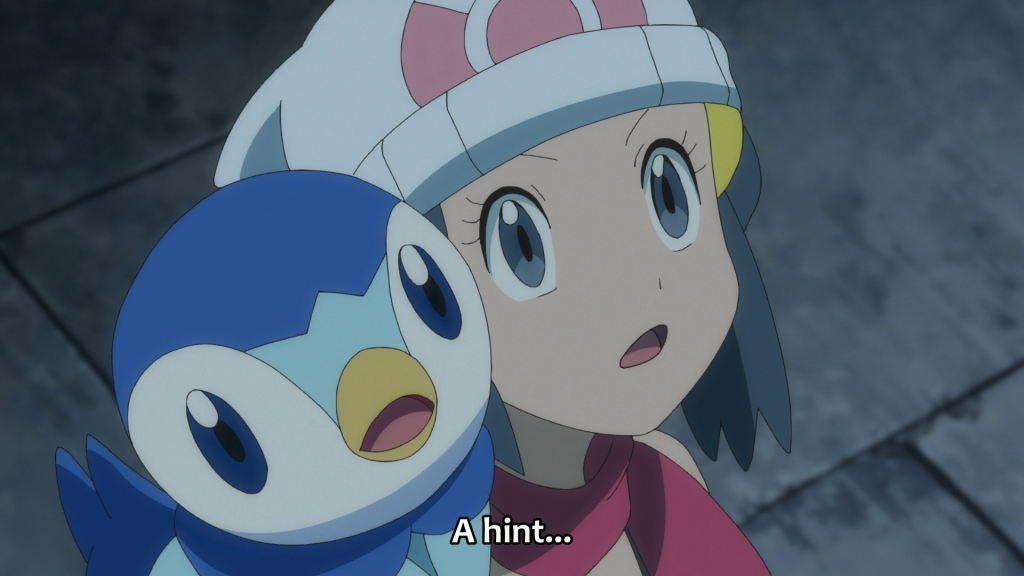


The world that grows with understanding
Arceus’ statement in Super Mystery Dungeon as well as the new texts on the plates from Legends Arceus seems to imply the idea of an original God who is both everything and nothingness, that in the beginning all possibilities and everything that could exist was a single existence. From that state, the oneness is split in as it’s perceived by different beings that are allowed to exist as split bodies and spirits of the All-God.
The main framework of reality is built, in the world that exists space is manifested to give the matter a place to be while time gives the matter change, with Willpower, Emotion, and Knowledge giving the matter the spirit to act, make relationships and understand their environment, something that makes the world grow more defined across infinite time and space.
On the other side of this world is that which doesn’t exist, a place that lacks time, space, and spirit. Although normally seen as a duality that brings conflict, the two need each other so they can, in a way, “exist”. Unbalance on one side affects the other that attempts to fix the unbalance and so one side supports the balance of the other, with the Spirit acting to also balance the world.
As humans and Pokémon adventure in the world, they can experience the infinite space and infinite time of this infinite world. As Masuda explained, this is what “Ultimate” means, as everyone who lives maintains the balance between the physical and the spiritual, the world will continue to exist.
“The key element was to create the storyline around the Pokemon in Sinnoh mythology. The relationship between all these Pokemon is the key element. I wanted to express the importance of the balance between substance — Dialga, the ruler of Time, and Palkia, the ruler of Space — and spirit — Uxie, Mesprit, Azelf. If the substance becomes too large, the balance of the spirit collapses. I wanted Dialga and Palkia to become counterparts for a sense of balance. Infinite time and infinite space — that to me is the ‘ultimate.’”
Junichi Masuda







However, if the world is shaped over time as the mind’s strengths, it means that originally the world was simpler with a smaller scope, and that reflects Pokémon itself really well. Originally the world of Pokémon was much closer to the real world as I explained in my very first post.
In the early years, Pokémon was more of a new mystery in the world, a recent discovery that challenged the notions of the real world, with researchers trying to learn more about them and how that changed their understanding of the world, or rather, the world. As ever since its inception, the notion was that Pokémon took place in various parallel worlds, and communication between them was necessary to reveal all the secrets of the “Pokémon World”.
For example, if there are person A and B and they trade monsters by communication, the one that A had will come to B. Then, when B meets C and they trade, what A had will go to C this time. In other words, it is possible that, unbeknownst to A, the Pokémon with which they was involved live somewhere in a parallel world. That’s what makes it interesting.
Satoshi Tajiri
Over time as new games were being developed that world became bigger and bigger. In fact, the world wasn’t becoming bigger only due to games, but also card games, anime, and many more products. The Pokémon World became bigger as each aspect of the franchise stimulated each other. With this, each new generation revealed more and more about that World, but in some ways, the world changed.
Future of Pokémon
Today, the world of Pokémon is evolving as games, cards, and animations stimulate each other. For example, Pokémon created in the games have become cards that bring out their individuality, and in the animated series, they are expressed in brave and cute ways, greatly expanding their appeal. In this way, the world of Pokémon continues to deepen and evolve in ever more interesting ways.
Enjoy Pokémon in various worlds
While the original settings of Pokémon presented an Earth-like world with recently discovered Pokémon being researched in a serious way for the first time, around the time of the 4th Generation this changed. During the 3rd Generation, there was still an idea of Pokémon being an Earth-like planet with a similar origin, and legends being mostly a misinterpretation of what actually happened caused by powerful Pokémon existing and ancient people not being able to understand it.
With the 4th generation, this changed. It was here where the idea of fully transforming the Pokémon world into a “fantasy world” was first talked about, as Masuda wanted to develop what he claimed to be the “ultimate world” the limitations of our real world and history needed to be surpassed. Maybe it made sense to start this with the generation that developed in detail the creation myth of the Pokémon world (The last time that happened was in Takeshi Shudo’s novels).
Creating a fun game is not enough. Tell no lies, and tackle the project with faith. A new challenge. The power to create from nothing. And the eagerness to make every detail right. We will draw the world of tomorrow, the world of distant future, on a blank paper called Pokemon. An ideal world. Also, an ultimate world. Hoping that people of all countries will shake hands with each other, hoping for the world of happiness, world full of love, we chose “Pearl,” a symbol of happiness, and “Diamond,” a symbol of love. To the next world, to the next stage. no matter how difficult it is, let’s run together in order to create a new world.
Junichi Masuda
Overall, I wanted to depict an ideal world, which was peaceful with no environmental issues or racism. The relationship between human beings and Pokemon characters is much closer than the owner-pet relationship, which is what I envision to be the ideal relationship. I want everyone to feel something when interacting with this world. In Japan, people sometimes don’t give up their seats for the elderly on a train. I wanted to show a world of kindness. It’s not just about what’s good and what’s bad, I wanted to show that there are even better ways to act than normal. For instance, the Pokemon Celebi is said to only appear when you help nature to flourish in a forest in the Pokemon world. Another example I’ve imagined is despite the normal reputation that electronics like refrigerators and trucks damage the environment or waste energy, these devices would be something closer to nature in the Pokemon world.
Junichi Masuda
What’s always in my mind when I create the concept of the Pokemon world is the idea of an ideal world–a fantasy world in a video game that humans in our world would want to live in. Also, what makes the Pokemon unique is their relationship with humans; the relationships aren’t merely that of an owner and his or her pet–it goes beyond that.
Junichi Masuda
Ever since references to the human world have been quickly disappearing from the series, they are being removed from the Pokédex entries, sometimes when they remake a world they change a real-world reference to its Pokémon counterpart, and so on. There was even a time when a Pokémon TV Special claimed that Pokémon live “far away on a planet far from Earth“. Of course, as presented in the special itself, some settings there were “jokes”, but Masuda did confirm once that the Pokémon world isn’t Earth, at least not anymore.
We actually don’t think of the world of Pokémon as Earth. If we were to do that, we would kind of be limited by what we could do. By thinking about how physical objects work on Earth and how various elements work on Earth, we would kind of be limited to that if we though of it as Earth. We think of it as a place that is really similar to Earth, but is a different planet of its own with people in it who may be similar to people on Earth, but they have different values so they care about different things. It’s the type of place, the Pokémon world, where problems we face on Earth just wouldn’t happen. There wouldn’t be global warming, water shortages, or anything like that. It’s a world where the people in it really want to work together with each other. Their value system is such where they would prefer to work together and eliminate these problems rather than feud.
Junichi Masuda
In a way, the evolution of the Pokémon world follows the creation myth with space and time being shaped as the creative mind develops and allows for a more precise perception of the Pokémon world.
However, since the world is shaped by their perceptions, the Pokémon world that each person believes and sees every time they play a game, read a manga, or watch an anime also exists. If someone prefers the world as it was before, that world didn’t cease to exist as it always returns every time you think about it and sees it with your own imagination. The ultimate world isn’t singular, infinite time and infinite space allow for infinite stories, after all…




Is really interesting seeing how the perception of the pokemon world changed through the franchise’s history. I also feel I got a more nuanced understanding of what we were intended to pick from the creation myth, and Dialga, Palkia and Giratina. Thanks for writing this, Ravel.
LikeLiked by 1 person
Es una publicación bastante interesante y la que me ha ampliado más información con respecto a lo que son el trio principal de las leyendas de Sinnoh/Hisui.
LikeLike